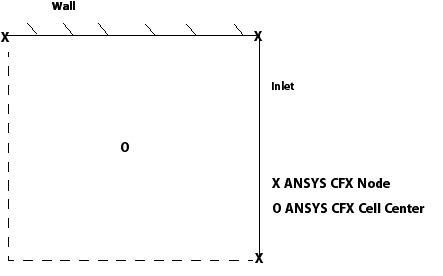CFD-Post can load dump files (*.d*mp*) created by CFX-4. When you load the results, you may be prompted to provide the solution units that were used in the simulation. For details, see CFD-Post Solution Units.
There is an important limitation with CFX-4 results files that should be noted: the CFX-4 Solver does not output minimum/maximum ranges for each of the calculated variables. These ranges are calculated when the results file is loaded by CFD-Post. Calculating the range for a very large problem would, however, require prohibitively large amounts of CPU time. As a result, range values are calculated for the loaded time step only. This means that values that appear as global range, are in fact ranges that exist for that time step only.
The CFX-4 Solver uses a cell-based solution method, whereas CFX-Solver uses a node-based solution method. Possible problems can be encountered at the intersection of patches, such as in the following diagram:

When interpolating from cell-centered to node-centered data, the data at a given node is affected by all surrounding cells. In order to get the correct behavior at boundary patches, a priority number is assigned to each patch by CFD-Post. This means that, for example in the above diagram, if the wall has a higher priority number than the inlet, the value of the node is interpolated from the wall value of the CFX solution. When considering a situation in 3D, the priority of all faces is read and interpolation occurs from the face(s) with the highest priority. CFD-Post uses the same default values for every problem, so there are cases in which accuracy can be compromised. These errors can be minimized by refining the grid density in the region around problem areas.
Quantitative calculations can suffer a loss of accuracy due to the limitation described above. The results of mass flow calculations should, therefore, be assumed to be approximations for the purposes of quantitative analysis.


